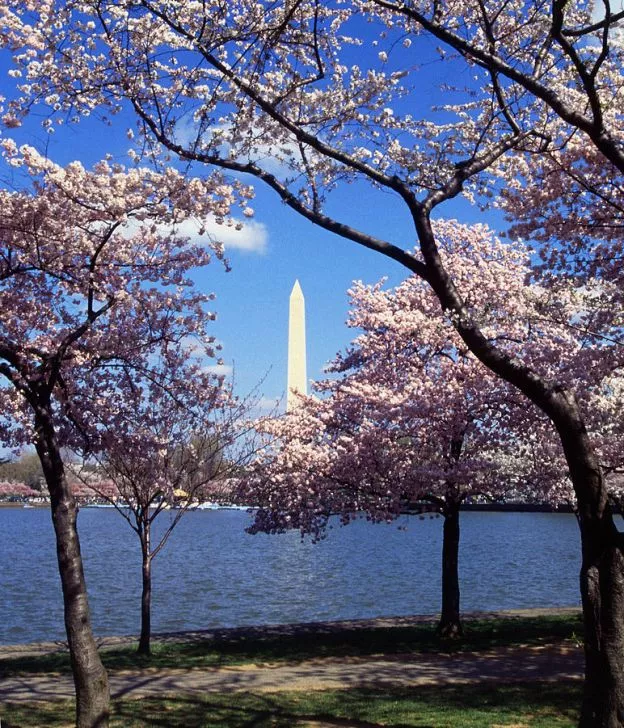
Flim-flamming the forest primeval
“The tree of liberty must be refreshed from time to time with the blood of patriots & tyrants.” So wrote Thomas Jefferson in a 1787 letter. Thomas Jefferson’s other rebellion.
A little rebellion now and then
A century and a half later, 50 American women, self-fashioned patriots, chained themselves to cherry trees to prevent a tyranny that Jefferson would never have predicted: bulldozers dead-set on uprooting hundreds of said trees. Why would these mechanical tyrants do such a thing? Easy: to commemorate Thomas Jefferson.
In November 1938, these women chained themselves to cherry trees in southwest Washington, D.C to protest the construction of the Thomas Jefferson Memorial. 88 of these beautiful trees were to face the wrath of marauding bulldozers, and these women sparked what is now known as the “Cherry Tree Rebellion” in order to save these Washington icons.
But why were the cherry trees planted there in the first place?
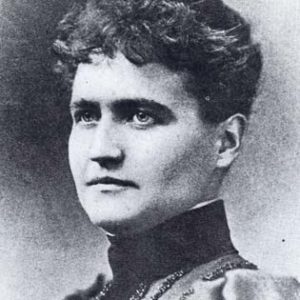
The American writer and photographer Eliza Scidmore became the first cherry tree advocate after visiting Ueno Park in Tokyo, Japan in 1885. When she returned to the United States later that year, she lobbied the U.S. Army Superintendent of the Office of Public Buildings and Grounds to plant the trees near the Potomac, showcasing her photos of the trees and the delicate blossoms that graced Tokyo each spring.
Alas, Scidmore’s efforts went unheeded until 1909, when that year she found two allies: U.S. Department of Agriculture official David Fairchild, who planted 100 of the trees on his estate in nearby Chevy Chase, Maryland to great success, and more importantly, First Lady Helen Taft. When the latter heard of Scidmore’s plans, she became an enthusiastic supporter, thanking Scidmore for her plans to beautify the capital. The First Lady explained, “I have taken the matter up and am promised the trees, but I thought perhaps it would be best to make an avenue of them.”
Two days later, the renowned Japanese chemist Jokichi Takamine and Japanese diplomat Kokichi Midzuno contacted the Mayor of Tokyo, Yukio Ozaki about the matter. Ozaki responded generously, sending 2,000 cherry trees to the U.S. Unfortunately, this first wave of cherry trees succumbed to insects and disease, and had to be burned upon arrival.
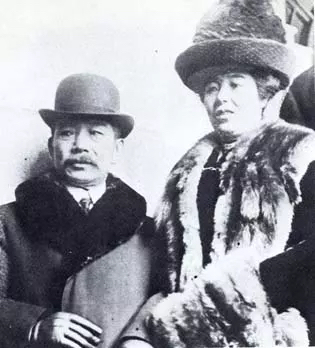
A second shipment of trees – over 3,000 of them – reached the U.S. in 1912. With Scidmore in attendance, First Lady Helen Taft and Viscountess Chinda Iwa, wife of the Japanese ambassador, planted the first two trees, which still stand today. So many cherry trees were planted in subsequent years that they became an iconic feature of the city, attracting about one-million tourists each spring to see them in full-bloom. As one contemporary commented, southwest Washington was no longer the “forest primeval,” but a wondrous sacred grove adorned with cherry trees.
The history of the Thomas Jefferson Memorial runs parallel to that of the cherry trees. In 1902 the U.S. Senate Park Commission adopted plans to “restore and amplify” the grandeur of the capital, which included creating a memorial site on the western bank of the Potomac River.
Fast-forward to 1926 (15 years into the cherry tree era), and Congress introduced a resolution to erect a memorial to Thomas Jefferson. Proponents of this memorial, especially Democratic politicians who claimed Thomas Jefferson as the founder of their party, saw a travesty in the fact that the man who crafted the Declaration of Independence lacked “practically no memorial of any kind.” And that lament, not coincidentally, came from arguably the most powerful Democratic president in American history: Franklin Delano Roosevelt.
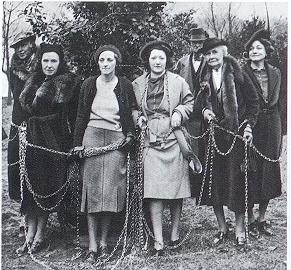
The ascension of FDR to the presidency rekindled hopes of building a memorial to their party’s founder, one that would act as an inspirational monument dedicated to patriotism and a welcome sight to many Americans stuck in the doldrums of the Great Depression.
Enter John Russell Pope, the architect who designed the National Archives building. Pope had an affinity for the classical tradition that dovetailed with Jefferson’s own love of ancient history. His design borrowed from the awe-inspiring dome and imposing columns of the Roman Pantheon, a structure Jefferson adored and mentioned frequently in his writings. Inside the memorial, four panels of quotations representing Jefferson’s contribution to American political thought emblazoned the walls, including selections from his personal letters as well as the Declaration of Independence, A Bill for Establishing Religious Freedom, and Notes on the State of Virginia. The sculptor Rudulph Hess designed the statue of Jefferson, and by 1947, the 10,000 lbs. bronze sculpture had been installed facing the Tidal Basin.
The words chiseled around the dome’s rotunda spoke as much to Jefferson’s character as to the controversy over the cherry trees: “I have sworn upon the altar of God eternal hostility against every form of tyranny over the mind of man.”
The first controversy came from the selection of Pope as the chief architect. Many critics complained that his classical leanings would produce not a monument, but a “pompous pile,” “a senile sham,” and a “cold mausoleum imitation of imperial Rome.” The second controversy came from the cost of the memorial, a cool $3 million appropriated by Congress in spite of the Great Depression: some viewed such extravagance as an insult to unemployed Americans.
Yet the Commission and their supporters steamrolled – or in this case, bulldozed – their way through these complaints, and at the behest of FDR himself, chose to relocate the memorial from the relatively cramped quarters of northwest Washington to the Tidal Basin in the southwest corner of the city. Doing so meant uprooting dozens, possibly hundreds of the now-iconic cherry trees.
Enter the third controversy
The outbreak of hostilities known as the Cherry Tree Rebellion. The rebel leader, Eleanor “Cissy” Patterson, the owner and editor of the Washington Times-Herald, and a scathing opponent of FDR, clamored for a mass protest at the site of the memorial. Patterson and her supporters viewed cutting down the trees as an abomination and ruinous to Americans who traveled to Washington each year to witness the blossoming springtime vista. Various high-profile women’s groups, including the District of Columbia Federation of Women’s Clubs, the District of Columbia Parent-Teacher Association, and the Housekeepers’ Alliance, rallied around Patterson, meeting and drafting resolutions intended to produce a public outcry and foil FDR’s tyrannical plans.
A group of 50 women marched to the White House on November 17, 1938, to present FDR with their petition to no effect – but the rebellion was far from over.
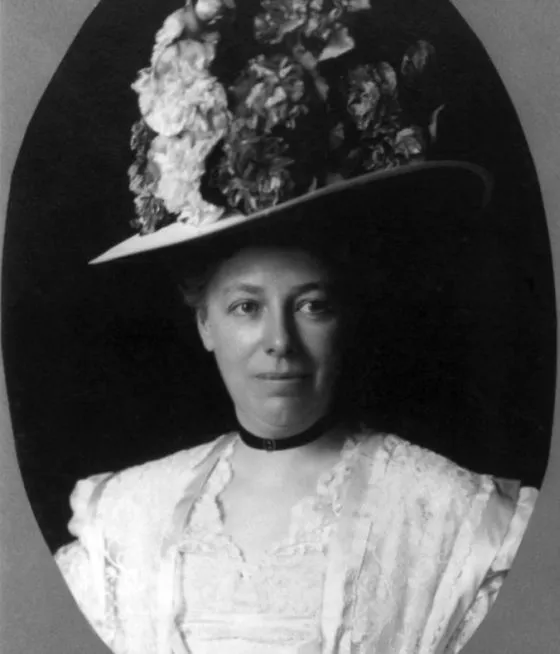
The first controversy came from the selection of Pope as the chief architect. Many critics complained with their petition to no effect – but the rebellion was far from over.
Setting their sights higher, the next day an “aggressive army” of 150 women invaded the memorial site. This feminine blitzkrieg seized shovels from the workmen, threw dirt back into the holes, and aimed their salvos towards anyone within earshot, complaining of the “congressional double-cross.” 50 women then emerged from the crowd and chained themselves to 50 proscribed cherry trees, chanting lines from Joyce Kilmer’s poem, “Trees.” The bulldozers stopped their advance and for the moment at least, the trees were safe. According to the National Park Service, the stalemate ended only after the Assistant Secretary of the Interior Michael Strauss brought them lunch. “After never-ending cups of coffee, the ladies’ need for restrooms hastened their decision to remove the chains.” The Cherry Tree Rebellion came to a bloodless conclusion.
As might be expected, the press had a field day discussing the Cherry Tree rebels with FDR later that day. Calling the entire rebellion “the worst case of flim-flamming that this dear old capital of ours has been subjected to for a long time,” FDR pointed out that 40-50 cherry trees were chopped down, transplanted, or succumbed to old age each year without fanfare. True, he admitted, constructing the memorial would destroy 88 cherry trees. Then, in a cunning, possibly extemporaneous move, FDR suggested “we ought to have, in addition to the 1,700 trees we have today, I think another thousand cherry trees. There are lots of places to put another thousand trees. Let us plant 2,700 trees instead of 1,700.” This net gain of 912 trees apparently satisfied the rebels, and sure enough, the Cherry Tree Rebellion ended.
We will never know what Thomas Jefferson would have made of this entire ordeal – but he once wrote to James Madison that “a little rebellion now and then is a good thing.” The Cherry Tree Rebellion may have failed, though the women’s willingness to stand up to the government for what they believed in flowered from the seed Jefferson planted long, long ago.
This post also appeared as an article on RealClear History.
Elliott Drago serves as the JMC’s Editorial Officer. He is a historian of American history and the author of Street Diplomacy: The Politics of Slavery and Freedom in Philadelphia, 1820-1850 (Johns-Hopkins University Press, 2022).
